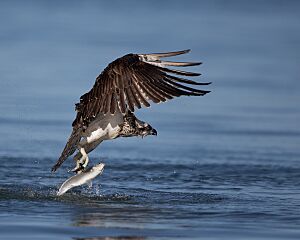Peel-Harvey Estuarine System facts for kids
The Peel-Harvey Estuarine System is a big natural water area in Western Australia. It's south of the town of Mandurah. The local Bindjareb Noongar people call it Nyungar: Djilba.
A road called the Old Coast Road runs between the Indian Ocean and this water system. To the east, the Forrest Highway is a main road. It connects Perth to coastal towns like Bunbury and Busselton.
Contents
Exploring the Peel-Harvey Estuary
The Peel-Harvey Estuary is known as Djilba by the Bindjareb Noongar people. It covers a large area, about 131 to 136 square kilometers in total. The water is usually quite shallow, around 1 to 2 meters deep.
The Harvey Estuary is a long stretch of water. The Harvey River flows into its southern end. This part of the estuary is about 56 to 61 square kilometers.
The Harvey Estuary then flows into the Peel Inlet. This inlet is more circular and covers about 75 square kilometers. The Serpentine River and Murray River also flow into the eastern side of Peel Inlet.
A 5-kilometer long channel connects the estuary to the ocean. This channel is called the Mandurah Estuary or Mandurah Channel. It runs right through the town of Mandurah.
Keeping the Water Clean
For many years, the estuary had a big problem with algal blooms. These are like thick green mats of algae. They were caused by too many nutrients flowing into the water. These nutrients came from farms and piggeries nearby.
To fix this, a new artificial channel was built. It opened in 1994 and is called the Dawesville Channel. This channel helps ocean water flow into the estuary regularly. The ocean water helps to clean and flush out the estuary.
This flushing has changed the estuary's environment a lot. But overall, the water quality has become much better.
The Land Around the Estuary
The land to the east of the estuary is mostly flat. It's called a coastal plain. About 75% of the natural plants have been cleared away. This land is now used for farming, like raising dairy cows and beef cattle.
In the past, people cleared the land for farming. Drainage systems were also built. These systems help to quickly remove extra water from the land. This water then flows into the three main rivers that feed the estuary.
Wildlife in the Peel-Harvey Estuary
The estuary is a home for many different animals. You can find crustaceans like the tasty blue swimmer crab and the western king prawn. Many types of fish live here too, such as black bream, mulloway, tailor, and cobbler. You might also see dolphins visiting the estuary often.
Important Bird Area
The Peel-Harvey Estuary is very important for birds. BirdLife International has named it an Important Bird Area. This means it's a special place for birds.
Many fairy terns live here. It's also a safe place for blue-billed ducks during dry times. Sometimes, more than 1% of the world's population of certain birds can be found here. These include red-necked stints, sharp-tailed sandpipers, banded stilts, red-necked avocets, and red-capped plovers.
Fun Things to Do at the Estuary
The estuary is a popular spot for fun activities. Many people enjoy boating and fishing here. There are lots of boat ramps and picnic areas along the shore. You can find shaded sandy beaches perfect for relaxing.
You can even rent houseboats in Mandurah. This lets you explore the estuary and the Murray River by water.
Protecting the Estuary's Future
More and more houses are being built along the estuary's shores. New canal developments are also happening in Mandurah and at North and South Yunderup. These developments create challenges for keeping the estuary healthy in the future. It's important to manage these changes carefully to protect this special place.


